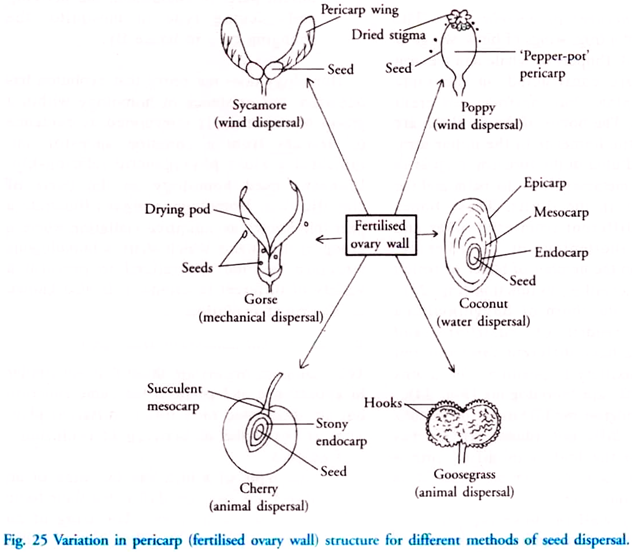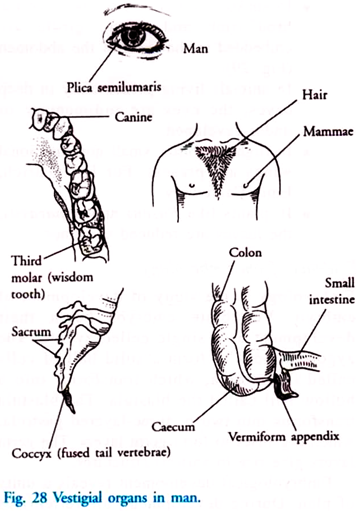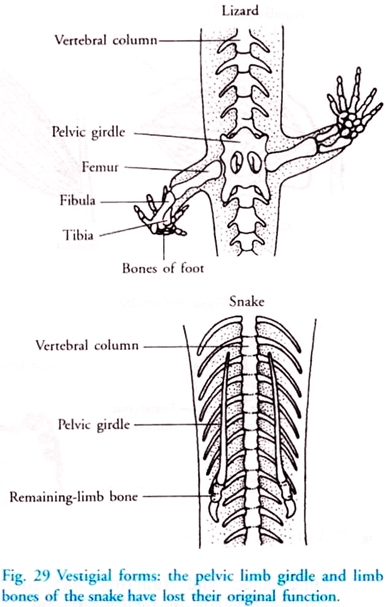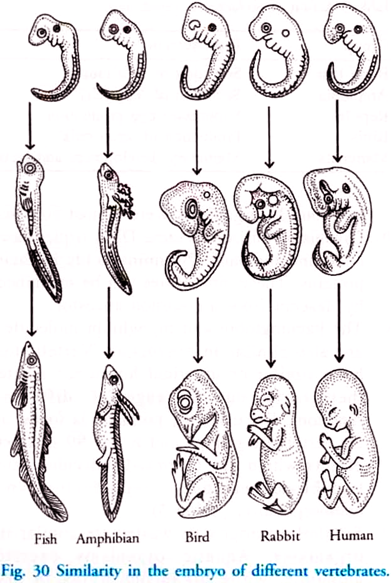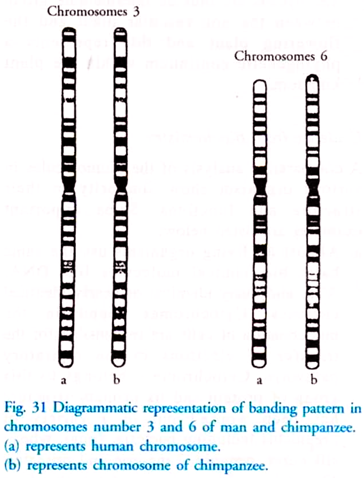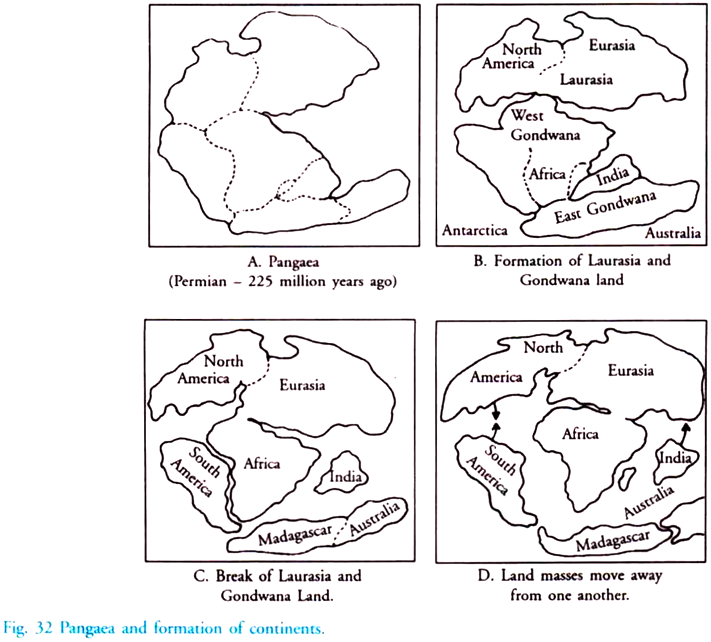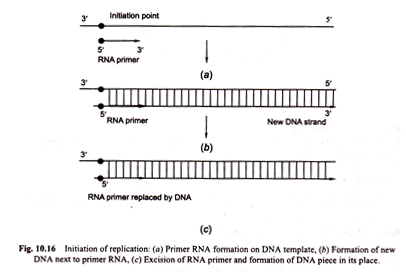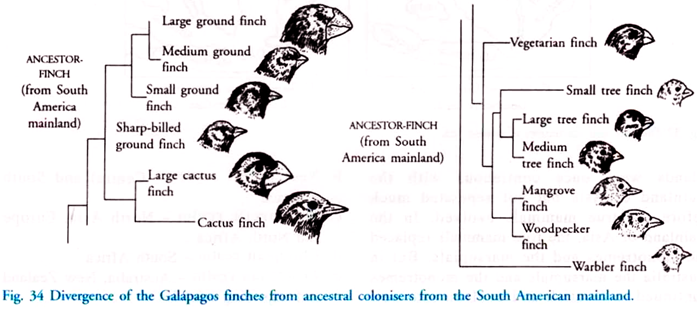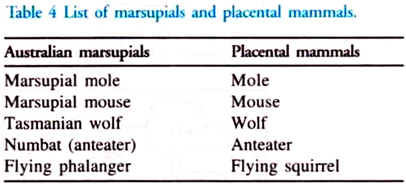ADVERTISEMENTS:
The theory of organic evolution seems to be the most acceptable explanation of the occurrence of varied forms of plants and animals on Earth. Evolution, which started out as a hypothesis, is now supported by evidence from many fields of science. The various convincing evidences for the occurrence of descent with modification is summarised in the Fig. 15.
1. Evidence from Palaeontology:
The study of fossils is called palaeontology. Fossils not only refer to evidence of bones, teeth and other hard parts but to any impression or imprint by an organism in soft mud that subsequently hardens or moulds and casts of entire organisms. Most of the fossils are found in sedimentary rocks and are at least 10,000 years old.
ADVERTISEMENTS:
The study of fossils reveal the existence of life in the past and illustrates the course of evolution of plants and animals.
The following facts can be established by fossil records:
a. Fossils are remains of organisms that lived in the past.
ADVERTISEMENTS:
b. There is a gradual complexity in the organisation of fossils. The fossils in the bottom layers have simple organisation and become more and more complex in the layers above them.
c. Transitional fossils or connecting links are known to link major groups – like fishes to amphibians, from amphibians to reptiles, from reptiles to birds and mammals.
d. The mammals are recent products of evolution, while angiosperms are among the recent plants. The geological time scale gives us an idea of the distribution of plants and animals in the geological time.
e. The fossil record in majority of cases is incomplete, but in certain mammals like horse, camel and elephant, the records are complete, indicating how evolution has occurred.
Based on various theories the proponents have estimated the period of origin of life on Earth differently. Geologists have prepared a time-table to depict the period when the different groups of organisms came into existence. The geological time is divided into five eras, which are further differentiated into periods (Table 2).
It is estimated that life appeared about 700 million years ago. In the Archaeozoic era the organisms were soft bodied and therefore fossil remains are lacking. In the Proterozoic era sponges, coelenterates like corals, segmented worms, algae and fungi were found. In the Cambrian period of the Palaeozoic era, only invertebrates were present. In the Ordovician period, the first jawless armoured finless fishes appeared.
Terrestrial organisms appeared in the Silurian period, amphibians in the Devonian period. The reptiles appeared in the Permian period. These diversified and dominated the Earth in the Mesozoic era. This period is called the ‘Age of the reptiles’. Mammals and birds arose from the reptiles in the Triassic and the Jurassic period respectively. The Coenozoic era is the ‘age of the mammals’.
The fossil record is incomplete in most of the cases. But in certain mammals like the horse, elephant and the camel the fossils are arranged period wise. The fossil record of the horse is an excellent example for paleontological evidence.
ADVERTISEMENTS:
Evolution of Horse:
The earliest ancestor of the horse was Eohippus or Hyracotherium living in the plains of North America in the Eocene period. It had five toes and was the size of the present day dog. It was replaced by the Mesohippus and Miohippus that lived in the Oligocene period. The Miocene horse was Merychippus, which was the size of the pony and had three toes in the fore and three in the hind leg respectively.
The median toe was longer and bore the entire body weight. In Pliocene, the Merychippus was replaced by Pliohippus and in the Pleistocene by the Equus. In all these forms, only the median toe touched the ground and bore a prominent hoof. Equus resembled the modern horse (Fig. 16).
Fossil evidence supports the common descent hypothesis. Fossils have been found linking major groups of vertebrates. For example Archaeopteryx is between reptiles and birds; Eustheopteron is an amphibious fish which bears lungs for resporation; Seymouria is a reptile-like amphibian; therapsids were mammal-like reptiles. These are called as connecting links (Figs. 17-19).
Some organisms living today are similar to ancient life forms. An example is archaebacteria. Today this group is restricted to marginal environment i.e., in not spring water.
ADVERTISEMENTS:
Living fossils, like the coelacanth, ginkgo, and horseshoe crab, are examples of organisms that are relatively unchanged from their distant ancestors (Fig. 20).
Plant fossils are relatively much lesser as compared to animals. This is because animals possess hard structures that can be easily preserved which are not the case with plants.
The fossil records of some protist and plant groups are shown in Fig. 21. The width of the shaded space is an indicator of the number of species. Similarly, the fossil records of animal groups is shown in Fig. 22.
2. Evidences from Morphology and Comparative Anatomy:
Morphology is the study of external form and structure of various organs while the study of internal structure is called anatomy. The various organ systems of vertebrates indicate that they are constructed on a basic plan. For example the blood vascular system is made of the heart, arteries and the veins, while the excretory system is made of kidneys in all vertebrates.
A gradual development and modification in the various organ systems is seen, as an organism becomes more and more complex. For example, the heart is two-chambered in fishes, three-chambered in amphibians, four-chambered in crocodiles, birds and mammals. A similar elaboration is also seen in the structure of the brain in the various groups of vertebrates. The vertebrate brain is made of the olfactory lobes, cerebral hemisphere, optic lobe, cerebellum and the medulla oblongata.
a. Homology and Homologous Organs:
Richard Owen introduced the term ‘homologous’ to those organs that have a common origin and built on the same fundamental pattern but perform different functions and are morphologically different from each other.
Examples:
ADVERTISEMENTS:
i. Limb Structures of Vertebrates – The forelimb of a frog, wings of birds, wings of bat and seal, flippers of whale and the arm of man are constructed on the same general plan, but perform different functions. The bones of the forelimb are made of the humerus in the upper arm, radius and ulna in the forearm, carpals in the wrist, metacarpals in the palm and the phalanges in the digits. These bones become different from each other and include shortening or lengthening, decrease in the number of bones or fusion of bones according to function (Fig. 23).
ii. In plants, the thorn of Bougainvillaea and the tendril of Passiflora and Cucurbita have different functions but both are axillary in position. The thorns and tendrils are homologous (Fig. 24).
iii. Leaves undergo modifications of various kinds in different plants. In Cactus (Opuntia) the leaf is modified into a spine, in Lathyrus (sweet pea) it is modified into a tendril.
iv. The ovary wall in flowering plants is modified after fertilization in a variety of ways to aid in seed dispersal (Fig 25).
v. Insect mouth parts are made of the same parts – labrum, labium, mandibles, maxillae and hypopharynx. But in different insects they are modified differently – the biting and chewing mouth parts in cockroach, the piercing and sucking type in mosquito, the sponging type in house fly.
Homology does not prove that evolution has occurred; the existence of homology within a group of organism is interpreted as evidence of descent from a common ancestor and indicates a close phylogenetic relationship. Linnaeus used homology as the basis of classification. Homologous organs illustrate a principle known as adaptive radiation where a group of organisms which share a homologous structure become specialized to perform a variety of different functions. It is also known as divergent evolution.
b. Analogy and Analogous Structures:
The analogous organs are those that are similar in appearance and perform the same function but are developed on a totally different plan. They are examples of convergent evolution.
Examples:
i. The wing of a bird and the wing of an insect are used for flying, but their basic structure is different. The wing of an insect is formed of a thin flap of chitin and stiffened by veins, but in birds, the flight surface is formed by feathers that are attached to the bones of the forelimb (Fig. 26).
ii. Similarly, the fins of fishes, flippers of whales and penguin have similar appearance and function but their structural details are totally different.
iii. Sting of honeybee and scorpion – the sting of both these organisms are different structurally but functionally they serve the same purpose.
iv. The underground tuberous root of sweet potato and the underground stem modification of potato are meant for storage.
v. The tendril in edible pea is a modified leaflet, in Passiflora, a stem tendril, in wild pea a whole leaf tendril, while in Gloriosa the tip of the leaf is modified as a tendril (Fig. 27).
c. Vestigial Organs:
Vestigial structures are remains of a structure that was functional in some ancestor but is no longer functional in the organism. They are degenerate and non-functional. They are found in plants and animals, including humans.
i. Vestigial Organs in Man:
Man possesses nearly 100 vestigial organs.
Some prominent examples (Fig. 28) are as follows:
a. Vermiform appendix in man is the remnant of the caecum that is a large functional structure present at the junction of the small and the large intestine. It helps in the digestion of cellulose. This structure indicates that perhaps the ancestors of man ate only vegetable matter where the caecum played an important role. But as evolution progressed this organ underwent reduction in size and became vestigial.
b. At the inner angle of each eye, there is a completely unstretchable membrane called the nictitating membrane or plica semilunaris. In lower animals, it can be stretched across the eye when the animal is under water.
c. Early embryonic stages in man possesses a short tail that reduces in size very early during development.
d. The external lobe of ear is of no benefit to man, but it might have had some function in the ancestors of man.
ii. Vestigial Organs in Other Organisms:
a. In snakes, vestiges of the bone of the hind limb and pelvic girdle are embedded in the flesh of the abdomen (Fig. 29).
b. In animals living permanently in deep caves, the eyes are rudimentary or under-developed.
c. In flightless birds, small non-functional wings are present. For E.g. Ostrich, Emu, Cassowary
d. In plants like Ruscus and Asparagus, the leaves are reduced to spines.
3. Evidences from Embryology:
Embryology is the study of development of embryo. Vertebrate embryos begin their development as a single celled zygote. The zygote divides to form a solid ball of cells called the morula, which transforms into a hollow ball called the blastula. The blastula transforms into two or three-layered gastrula, which organises to form germ layers. The germ layers give rise to various structures.
Embryological development reveals a unity of plan. During development, all vertebrates have a notochord and paired pharyngeal pouches. In fish and amphibian larvae, the pouches become gills. In humans, the first pair of pouches becomes a cavity of middle ear and auditory tube; the second pair becomes tonsils, while third and fourth pairs become thymus and parathyroid glands.
Von Baer, the father of modern embryology, observed that certain organs are common to all vertebrates such as brain, spinal cord, axial skeleton, etc. Special features of the group such as hair in mammals, feathers in birds, develop at a later stage of embryonic development.
Haeckel formulated the ‘recapitulation theory’ or the ‘biogenetic law’. The law states as follows – ‘Ontogeny recapitulates phylogeny’ Ontogeny is the development of the organism starting from the ovum, while phylogeny is the evolutionary history of the individual. According to the law, during the embryonic development of an organism, it recalls its entire evolutionary history.
The recapitulation theory can be understood with the following explanation:
a. The fertilised egg or zygote is comparable to the single celled ancestor.
b. The blastula is comparable to a colonial protozoan.
c. Gastrula, which is a two-layered, cup shaped mass of cells, is comparable to a coelenterate.
d. The three-layered embryo is comparable to a flatworm.
e. Slowly it resembles the fish embryo; then a reptilian embryo and then finally develops mammalian characteristics. At about the seventh month, the human embryo resembles a baby ape, being completely covered with hair and having long limbs.
The early stages of embryos in all the vertebrates exhibit remarkable similarity and it is not easy to differentiate a human embryo from the embryo of a bird, reptile, amphibian and a fish. Fig. 30 depicts the great similarity in the early embryos of the forms mentioned above. As they progress they become more and more different.
In some cases, embryological evidences are the only source of establishing relationships. For example, tunicate larva possesses all the chordate characters but the adult form does not appear to possess chordate features. Thus, the larval history indicates the chordate nature of the unchordates.
The examples in plants are not well documented when compared to animals.
Some are as follows:
a. The early gametophyte of mosses and ferns are represented by the protonema which resembles the filamentous green alga from which it is thought to have developed.
b. The cone bearing plants shows features intermediate between plants, adapted to terrestrial existence and those plants which require water for the transfer of gametes. In the cone bearing cycads, the male gametophyte resembles the light dry pollen grains of the flowering plants, in cycads, the male gaveto swims to the ovule to bring about fertilisation. In flowering plants, however, the male gametes are non-motile.
The cycads are thus an intermediate group between the non-vascular plant and the flowering plant and this represents a phylogenetic continuum within the plant kingdom.
4. Evidence from Biochemistry:
A comparative analysis of the biomolecules in various organism show similarity in their structure and functions.
Some important examples are listed below:
a. Almost all living organisms use the same basic biochemical molecules like DNA, ATP, and many identical or nearly identical enzymes. Cytochromes found in the mitochondria of cells are responsible for the transfer of electrons in the respiratory pathways. Cytochrome c belongs to this group of protein and its primary structure has been worked out in a variety of organisms including bacteria, fungi, wheat, silkworm, penguin, kangaroo and primates. The amino acid sequences of cytochrome c in about 21 organisms were almost similar.
b. Organisms utilise the same DNA triplet base code and the same 20 amino acids in their proteins. These similarities can be explained by descent from a common ancestor.
c. The haemoglobin and myoglobin molecules are also similar in organisms. Vertebrates have similar or identical hormones where they carry out a range of different functions. For example, prolactin is found in all vertebrate groups and it has 90 distinct effects which can be broadly divided into two broad headings reproduction and osmoregulation (Table 3).
d. Similarly nitrogenous wastes are similar in organisms. Aquatic organisms excrete ammonia, while organisms living in dry environments excrete uric acid like birds and reptiles or urea like mammals.
e. The composition of blood and lymph is almost similar in most vertebrates.
f. Serum analysis also establishes relationships between various groups. The serum of man is closest to gorilla, followed by chimpanzee. Similarity is observed between the cow, sheep and goat; tiger, lion and leopard, etc. Fig. 31 shows the relative similarities between human DNA and DNA of chimpanzee.
Comparative serology has been used extensively to ascertain phylogenetic links. For example, zoologists were uncertain regarding the classification of the king crab, Limulus. When various arthropod antigens were added to Limulus serum, greatest amount of precipitation was produced by arachnid antigens. It is now firmly established that Limulus belongs to class Arachnida.
5. Evidences from Geographical Distribution:
The study of the geographical distribution of plants and animals is known as biogeography. The convincing evidence obtained in favour of natural selection is the phenomenon of discontinuous distribution. Many species have a wide range of distribution. If in some places a wide-ranging species becomes extinct, it would result in widely separated populations. This means that animals showing discontinuous distribution are descendants of the extinct population that had a wide range of distribution in the past. These became modified and became different from the population from which it originated.
This can be easily explained on the basis of organic evolution. The presence of marsupials and monotremes only in Australia and New Zealand can be explained as follows. These
islands were once continuous with the mainland of Asia but got separated much before the true mammals evolved. In the mainland of Asia, the true mammals replaced the monotremes and the marsupials. But in Australia the marsupials and the monotremes continued to flourish and evolved into new species.
According to Wegner (1912) Earth was at one time a single mass called Pangaea. This mass broke into the Northern Laurasia and the Southern Gondwana Land. From Laurasia, were formed. North America, Greenland and Eurasia. The Gondwana land formed South America, Africa, India, New Zealand, Antarctica and Australia. (Fig. 32)
Tectonic changes in time brought landmasses to lie in the position as they are now. Six realms are identified that are separated by geographical barriers like seas, mountains, deserts, etc.
They are as follows:
a. Nearctic realm – North America
b. Neo-tropical realm – Central and South America
c. Palaearctic realm – North Asia, Europe and North Africa
d. Ethiopian realm – South Africa
e. Australian realm – Australia, New Zealand and adjoining islands
f. Oriental realm – India, Sri Lanka, Malaysia, Indonesia and Philippines.
Similarly, in the Galapagos Islands, Darwin noticed that there were many endemic species of plants and animals. Similarly, Darwin observed that there were many different kinds of finches that were varied with respect to their beaks but were closely related to each other (Fig. 33).
According to Darwin, organisms that radiate to other geographical areas, where new environmental conditions exist, undergo adaptive changes. Over a long period of time they adapt themselves to that new location become categorised as new species. Such an evolutionary process where new species are formed and adapts to new habitats and ways of life is called adaptive radiation (Fig. 34).
Another example is the marsupial found in Australia. A number of different types of marsupial evolved from an ancestral stock (Fig. 35).
When adaptive radiation occurs in different groups in an isolated geographical area, with different habitats, similarity is observed. This can be referred to as convergent evolution. This is seen in placental mammals in Australia which exhibit similarities with the marsupials. Some examples are given in table below.












